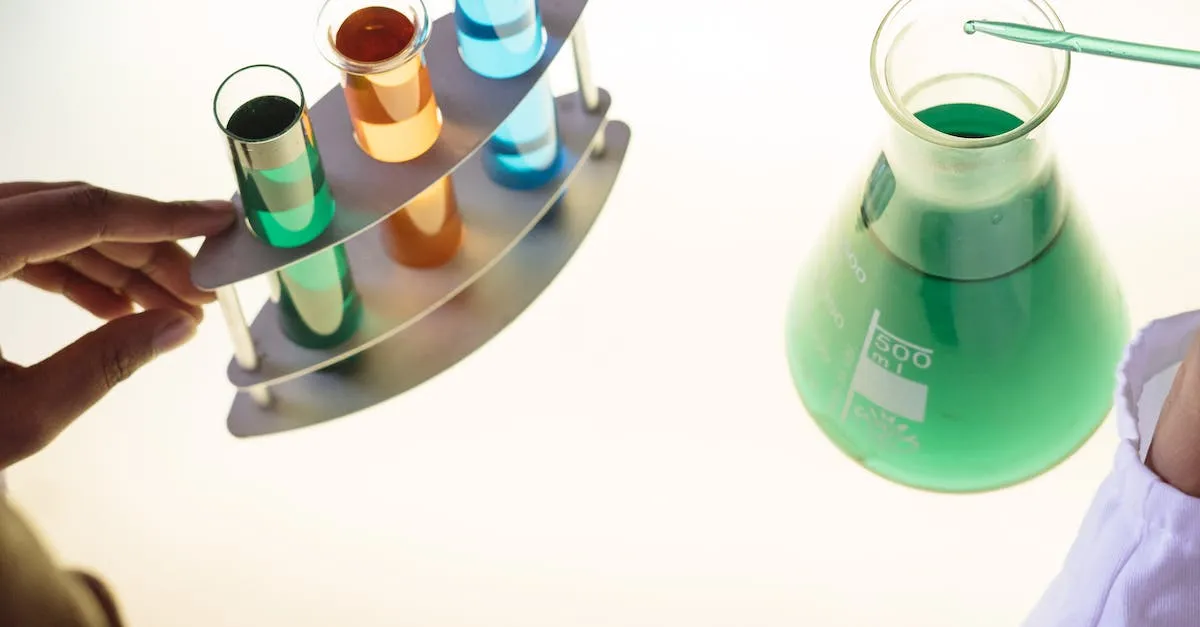The Color Of Science: An Exploration
Science encompasses a vast spectrum of disciplines and specialties, each with their own tools, techniques, and visual identity. But is there a singular color that represents the field as a whole? In this in-depth article, we’ll examine the rich symbolic color associations of science and the various palettes that bring scientific imagery to life.
If you’re short on time, here’s a quick take: While white lab coats and blue chemicals may jump to mind, there’s no single defining color for science. Science is multicolored, from the warm wood tones of archeology to the bright neon of biotechnology.
Read on as we dive into the meaningful colors used in each scientific realm.
The Traditional Hues of Science
When we think of science, we often imagine sterile laboratories filled with complex equipment and researchers in white lab coats. This traditional image of science has been ingrained in our minds for decades.
The colors associated with science not only serve a practical purpose but also contribute to the overall perception of the field. Let’s explore the traditional hues of science and their significance.
Crisp Whites
White lab coats have become synonymous with the scientific community. They represent purity, cleanliness, and a commitment to precision. The use of white lab coats can be traced back to the late 19th century when scientists began wearing them to protect their clothing from stains and to maintain a hygienic environment.
Today, the white lab coat serves as a symbol of professionalism and authority in the scientific field.
Furthermore, the color white reflects light, making it easier to observe and analyze substances in the lab. It also helps researchers easily identify any spills or contaminations. Cleanliness is paramount in scientific experiments, and the crisp white lab coat plays a crucial role in maintaining a sterile environment.
Cool Blues
Another color commonly associated with science is blue. From beakers and test tubes to safety goggles and gloves, blue is a prevalent hue in laboratories. This is not merely a coincidence; there is a scientific reason behind the choice of this color.
Blue is known to have a calming effect on the mind, which is essential in high-pressure scientific environments. It helps researchers maintain focus and concentration during intricate experiments. Additionally, blue is often used for safety equipment as it contrasts well with many hazardous substances, making it easier to detect any spills or leaks.
Laboratory Greens
Green is another color that can be frequently found in scientific settings. Laboratory equipment, such as pipettes and microscope slides, often feature shades of green. This color choice is not arbitrary; it has practical implications in the field of science.
Green is associated with growth, harmony, and balance. In a laboratory, it represents the pursuit of knowledge and innovation. The color green is also soothing to the eyes, reducing eye strain when scientists spend long hours examining samples under microscopes.
In addition, green is often used in safety signage and emergency equipment in laboratories. It stands out against other colors and helps researchers quickly locate safety exits, emergency showers, or eyewash stations in case of an accident.
Vibrant Colors of Scientific Imagery
Scientific imagery often captures the beauty of the natural world through vibrant colors. From microscopic biological structures to the explosive reactions in chemistry labs, these images provide a visual representation of the intricate processes that occur in the world of science.
Let’s explore some of the most striking colors found in different scientific disciplines.
Biology’s Greens and Reds
In the realm of biology, colors play a crucial role in understanding the intricacies of living organisms. Microscopic images of cells, tissues, and organisms often showcase a palette of greens and reds.
This is due to the presence of pigments such as chlorophyll, which gives plants their characteristic green color, and hemoglobin, which gives blood its red color. These vibrant hues provide researchers with valuable insights into cellular structures and processes.
For example, fluorescent dyes can be used to stain specific components of cells, allowing scientists to visualize and study the intricate network of proteins and organelles. The use of these dyes, combined with advanced imaging techniques, has revolutionized our understanding of cellular biology.
Chemistry’s Neon Rainbow
Chemistry, often associated with complex formulas and abstract concepts, also has a colorful side. In the world of chemical reactions, vibrant hues emerge as a result of complex molecular interactions.
From the neon glow of a glow stick to the brilliant colors of a fireworks display, chemistry brings forth a rainbow of stunning colors.
One example of colorful chemistry is the pH indicator. These substances change color depending on the acidity or alkalinity of a solution. Phenolphthalein, for instance, turns from colorless to pink in the presence of a base.
This allows chemists to visually determine the pH of a solution, making it a valuable tool in the lab.
Physics’ Deep Blues
Physics, the study of matter and energy, may not be commonly associated with vibrant colors. However, when it comes to the field of astrophysics, deep blues dominate the scene. Astronomical images capture the awe-inspiring beauty of the cosmos, displaying rich blue hues in nebulae, galaxies, and celestial bodies.
The deep blue color often signifies the presence of ionized oxygen molecules in space. These molecules emit light at specific wavelengths, resulting in the stunning blue color observed in many astronomical images.
By analyzing these colors, astronomers can gather valuable information about the composition and temperature of celestial objects.
From the greens and reds of biology to the neon rainbow of chemistry and the deep blues of physics, the vibrant colors found in scientific imagery not only captivate our eyes but also provide valuable insights into the workings of the natural world.
Exploring these colors allows us to appreciate the beauty and complexity of science, while also deepening our understanding of the phenomena that shape our universe.
Diverse Palettes Across the Sciences
Science is a vast field that encompasses a wide range of disciplines, each with its own unique color palette. From the earthy tones of archeology to the metallic shades of material science and the vibrant night skies of astronomy, the colors of science are as diverse as the subjects they study.
Earth Tones of Archeology
Archeology, the study of human history through the excavation and analysis of artifacts, is often associated with earthy tones. The colors of soil, clay, and stone play a significant role in the field, providing valuable clues about past civilizations.
Archaeologists carefully examine the layers of sediment, looking for variations in color and texture that may indicate the presence of ancient structures or artifacts. These earth tones not only help archeologists piece together the puzzle of the past but also add a sense of connection to our ancestors and the land they inhabited.
Metallic Shades of Material Science
Material science deals with the study of the properties and behavior of different materials, ranging from metals to polymers. In this field, metallic shades take center stage. Scientists work with a wide variety of metals, each with its own unique color and characteristics.
From the lustrous silver of aluminum to the brilliant gold of copper, these metallic hues not only add visual appeal but also provide valuable insights into the properties of materials. By understanding the colors and behavior of different metals, material scientists can develop new alloys and materials with enhanced properties, shaping the future of technology and innovation.
Night Skies of Astronomy
Astronomy, the study of celestial objects and phenomena, offers a color palette that is out of this world. From the deep blues of the daytime sky to the fiery reds and oranges of a sunset, the colors we experience on Earth are just a fraction of what the universe has to offer.
In the field of astronomy, scientists explore the night skies, capturing breathtaking images of galaxies, nebulae, and stars. These images showcase a stunning array of colors, from the vivid blues and purples of young stars to the warm yellows and reds of dying stars.
The colors of astronomy not only inspire awe and wonder but also provide valuable insights into the composition and evolution of our universe.
The diverse palettes across the sciences not only add visual interest but also serve as powerful tools for understanding the world around us. Whether it’s through the earthy tones of archeology, the metallic shades of material science, or the vibrant hues of astronomy, the colors of science bring beauty and knowledge together in a truly captivating way.
The Psychology of Color in Science
Color plays a significant role in science, not only in terms of aesthetics but also in terms of its psychological impact. Researchers have long been intrigued by the effects that different colors can have on our perception, cognition, and emotions.
Understanding the psychology of color in science can help scientists make informed decisions about color choices in their research, presentations, and data visualization.
Color Theory
Color theory is a field of study that examines how colors interact with each other and how they are perceived by humans. It explores concepts such as hue, saturation, and brightness, and studies the psychological and emotional responses that different colors evoke.
For example, warm colors like red and orange are often associated with energy and excitement, while cool colors like blue and green are often associated with calmness and relaxation. By applying color theory principles in scientific communication, researchers can effectively convey their findings and engage their audience.
Color Symbolism
Colors also carry symbolic meanings that can influence our perception and interpretation of scientific information. For instance, red is commonly associated with danger and caution, while green is often associated with safety and positivity.
These cultural associations and personal experiences can influence how we perceive scientific data and findings. Researchers should take these symbolic meanings into account when choosing colors for their graphs, charts, and visualizations to ensure that the intended message is effectively communicated.
Color Optimization
In addition to the psychological and symbolic aspects, color optimization is crucial in scientific research and data visualization. The choice of color palette can significantly impact the clarity and legibility of scientific graphs and charts.
Researchers should consider factors such as color contrast, color blindness accessibility, and the use of color gradients or shades to represent different data points. By optimizing the color scheme, scientists can enhance the visual appeal of their work and facilitate a better understanding of complex scientific concepts.
It is worth noting that cultural and individual differences can influence the psychological impact of colors. Therefore, it is important for researchers to consider their target audience and demographic when deciding on color choices in scientific communication.
By incorporating the psychology of color into scientific practices, researchers can create visually appealing, meaningful, and engaging content that effectively communicates their findings.
Science Museums and Exhibit Design
Color Schemes and Learning
When it comes to science museums and exhibit design, choosing the right color schemes can greatly impact the overall learning experience for visitors. Research has shown that certain colors can evoke specific emotions and stimulate cognitive processes.
For example, warm colors like red and orange are known to increase energy levels and attention, making them ideal for interactive exhibits that require active participation. On the other hand, cool colors like blue and green have a calming effect and can promote a sense of tranquility, making them suitable for areas where visitors can relax and reflect on the information they’ve learned.
According to a study conducted by the Smithsonian Institution, color can also play a role in memory retention. By using contrasting colors for important information or key concepts, museums can help visitors remember and recall the information more effectively.
Additionally, incorporating color-coding systems for different topics or themes can aid in organizing complex information and facilitating comprehension.
It’s important for science museums to consider the target audience when choosing color schemes. For instance, vibrant and bold colors may be more appealing to children, while more subdued and sophisticated colors may be preferred by adults.
By tailoring the color schemes to the intended audience, museums can create a more engaging and immersive learning experience.
Accessibility Considerations
Accessibility is a crucial aspect of exhibit design in science museums. It is essential to ensure that everyone, regardless of their abilities, can fully participate and engage with the exhibits. When it comes to color schemes, museums need to consider the needs of individuals with visual impairments or color blindness.
One best practice is to provide sufficient contrast between the background and text to ensure readability for individuals with visual impairments. The Web Content Accessibility Guidelines (WCAG) recommend a minimum contrast ratio of 4.5:1 for standard text and 3:1 for large text.
By adhering to these guidelines, science museums can ensure that their exhibits are accessible to a wider range of visitors.
Moreover, color-blindness affects a significant portion of the population. Designing exhibits with color-blindness in mind can be achieved by using complementary colors or different patterns to distinguish between different elements.
This will allow individuals with color blindness to still understand and engage with the information presented.
Best Practices
When designing exhibits for science museums, there are several best practices to consider:
- Balance: Achieve a balance between visual appeal and readability. Avoid overwhelming visitors with too many colors or cluttered designs.
- Consistency: Maintain consistency in color schemes throughout the museum to create a cohesive and unified experience.
- Integration: Integrate color with other design elements such as typography, graphics, and lighting to create a harmonious and immersive environment.
- Testing: Conduct user testing to gather feedback and make necessary adjustments to improve the overall visitor experience.
By following these best practices, science museums can create visually engaging and accessible exhibits that promote learning and discovery for visitors of all ages and abilities.
Conclusion
Science is anything but monochromatic. The vibrant hues used in scientific graphics, exhibits and environments bring complex subjects to life through meaningful color associations. While white and blue maintain traditional ties to the field, science encompasses a wide spectrum of specialties, tools and aesthetics.
There may not be one definitive color of science, but color itself plays an important role in scientific communication, understanding and discovery. Both in symbolism and design, color transforms science into a truly multicolored pursuit.







